ACCT 2013 Cost Management & Control Systems: Blindsforshine Case
VerifiedAdded on 2023/06/04
|10
|1542
|78
Case Study
AI Summary
This assignment presents a case study analysis of Blindsforshine Limited, focusing on budgets and variance analysis. It explores the reasons behind variances between budgeted and actual figures, including factors like fluctuating market conditions and inaccurate forecasting. The analysis includes variance calculations for various cost elements, such as faux wood, fabric, and labor costs, highlighting unfavorable variances exceeding 5%. Recommendations are provided to control variances through incentive programs, waste reduction, and activity-based costing. The study concludes that while budgeted figures serve as a guideline, incorporating uncertainty percentages and implementing cost control measures are crucial for minimizing variances and optimizing financial performance. Desklib offers this solution and many more to aid students in their studies.
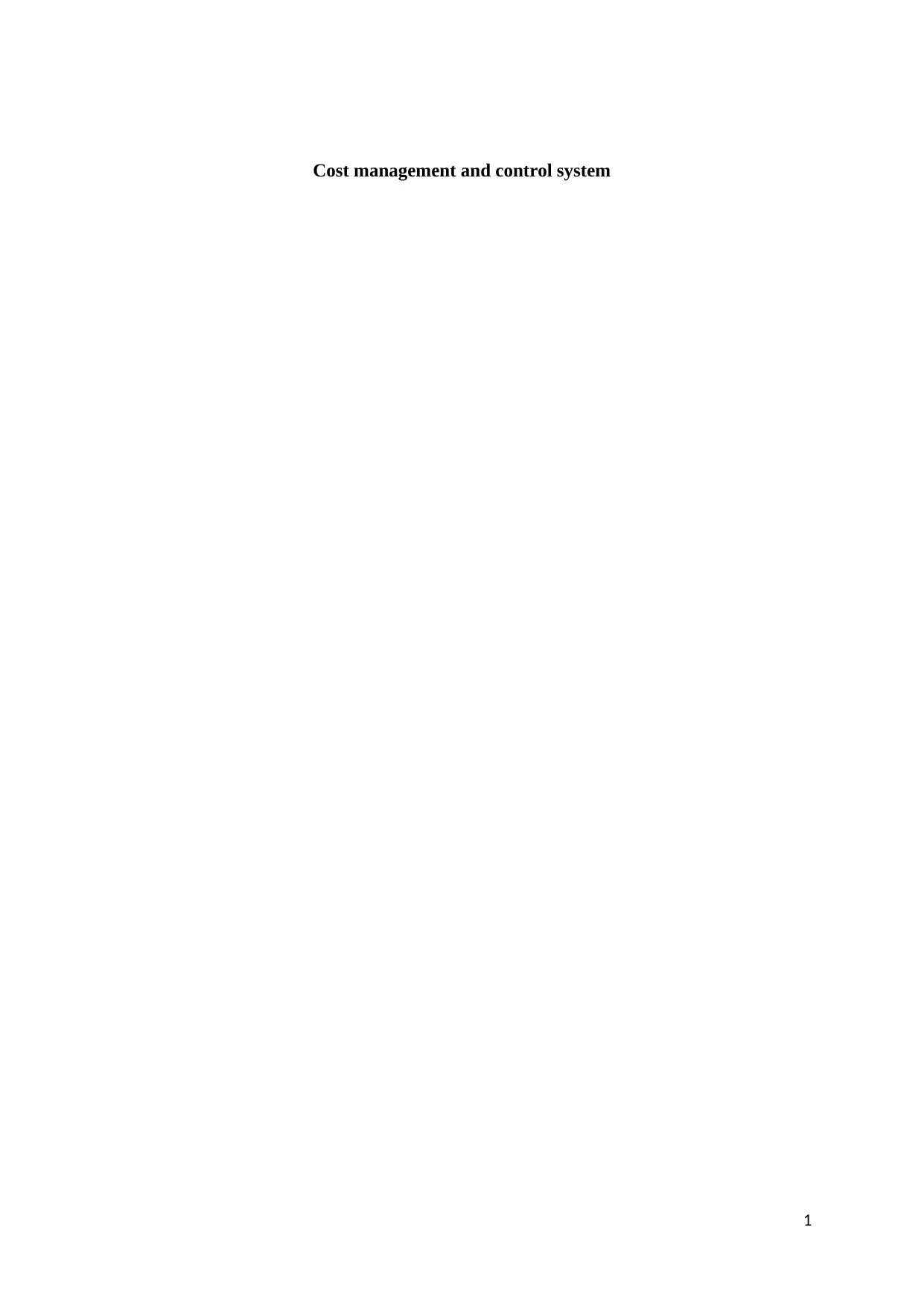
Cost management and control system
1
1
Paraphrase This Document
Need a fresh take? Get an instant paraphrase of this document with our AI Paraphraser
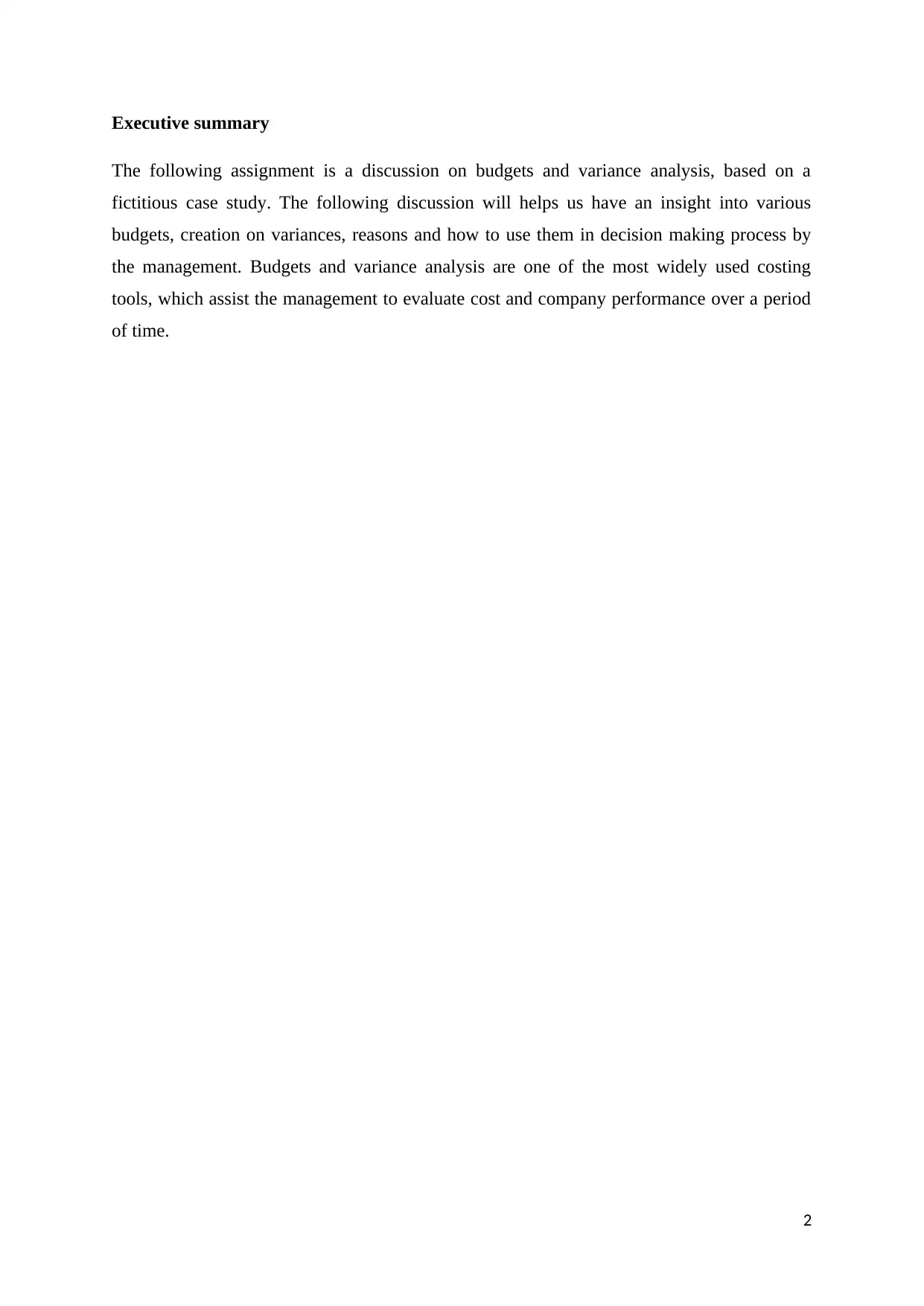
Executive summary
The following assignment is a discussion on budgets and variance analysis, based on a
fictitious case study. The following discussion will helps us have an insight into various
budgets, creation on variances, reasons and how to use them in decision making process by
the management. Budgets and variance analysis are one of the most widely used costing
tools, which assist the management to evaluate cost and company performance over a period
of time.
2
The following assignment is a discussion on budgets and variance analysis, based on a
fictitious case study. The following discussion will helps us have an insight into various
budgets, creation on variances, reasons and how to use them in decision making process by
the management. Budgets and variance analysis are one of the most widely used costing
tools, which assist the management to evaluate cost and company performance over a period
of time.
2
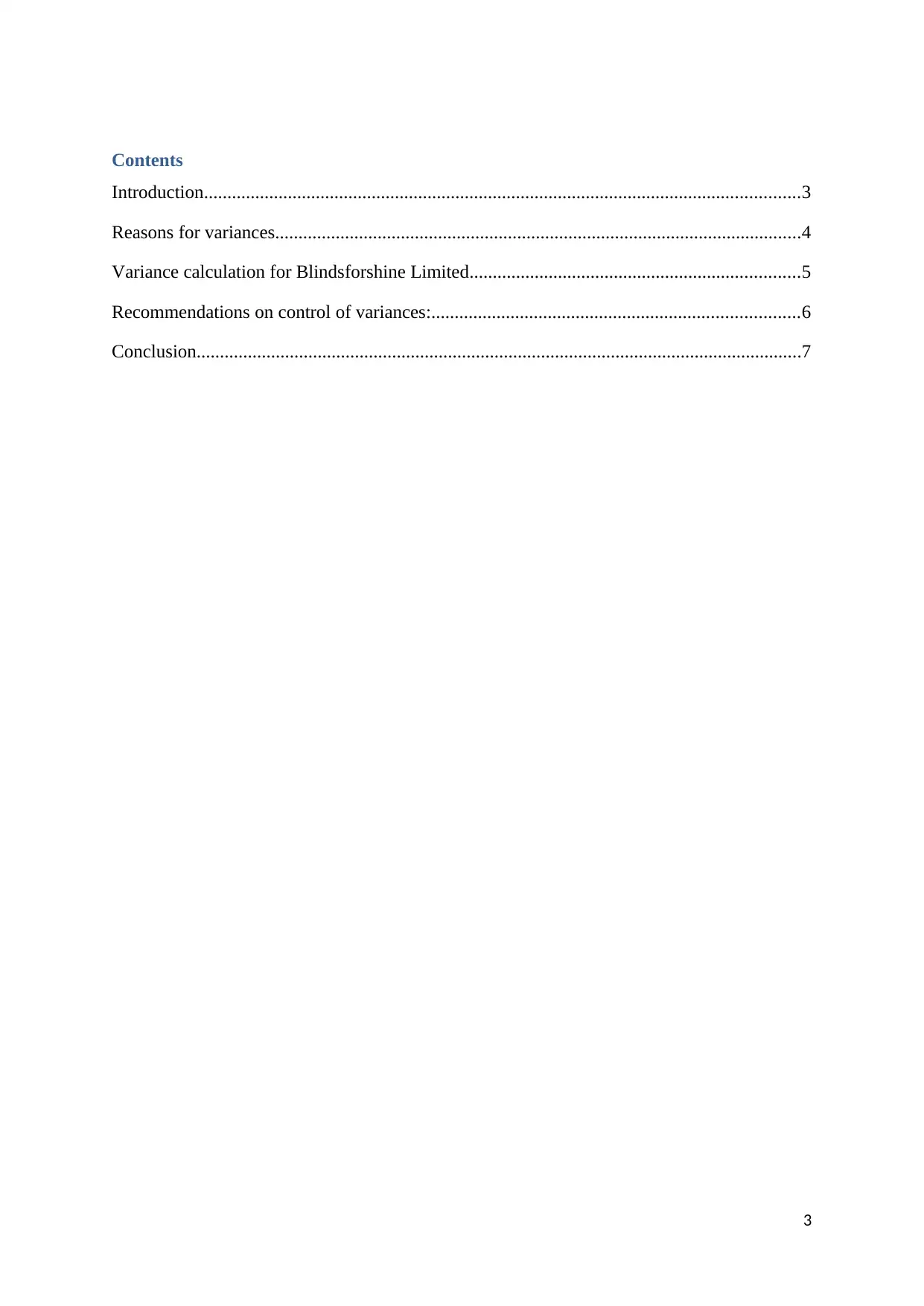
Contents
Introduction................................................................................................................................3
Reasons for variances.................................................................................................................4
Variance calculation for Blindsforshine Limited.......................................................................5
Recommendations on control of variances:...............................................................................6
Conclusion..................................................................................................................................7
3
Introduction................................................................................................................................3
Reasons for variances.................................................................................................................4
Variance calculation for Blindsforshine Limited.......................................................................5
Recommendations on control of variances:...............................................................................6
Conclusion..................................................................................................................................7
3
⊘ This is a preview!⊘
Do you want full access?
Subscribe today to unlock all pages.

Trusted by 1+ million students worldwide
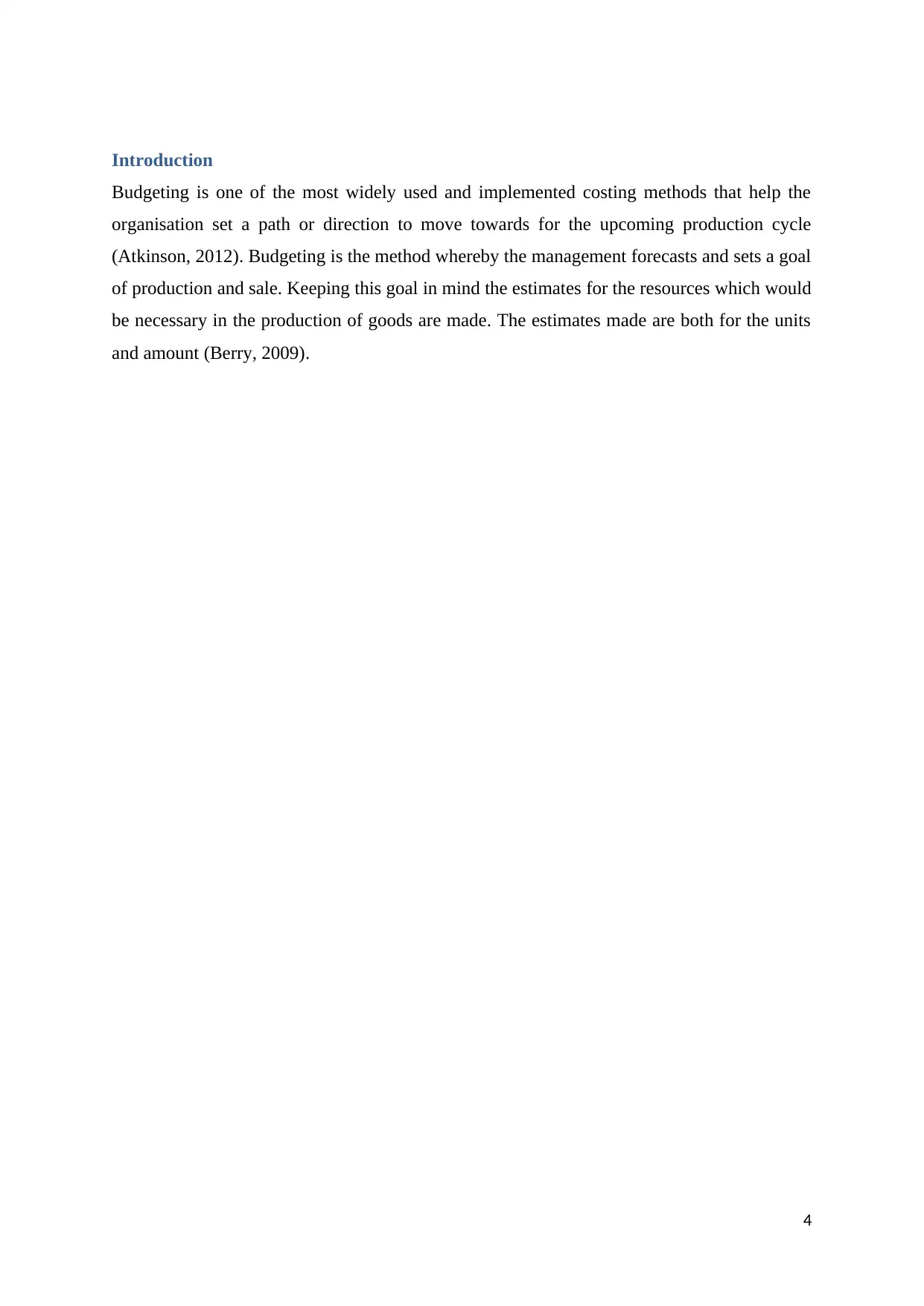
Introduction
Budgeting is one of the most widely used and implemented costing methods that help the
organisation set a path or direction to move towards for the upcoming production cycle
(Atkinson, 2012). Budgeting is the method whereby the management forecasts and sets a goal
of production and sale. Keeping this goal in mind the estimates for the resources which would
be necessary in the production of goods are made. The estimates made are both for the units
and amount (Berry, 2009).
4
Budgeting is one of the most widely used and implemented costing methods that help the
organisation set a path or direction to move towards for the upcoming production cycle
(Atkinson, 2012). Budgeting is the method whereby the management forecasts and sets a goal
of production and sale. Keeping this goal in mind the estimates for the resources which would
be necessary in the production of goods are made. The estimates made are both for the units
and amount (Berry, 2009).
4
Paraphrase This Document
Need a fresh take? Get an instant paraphrase of this document with our AI Paraphraser
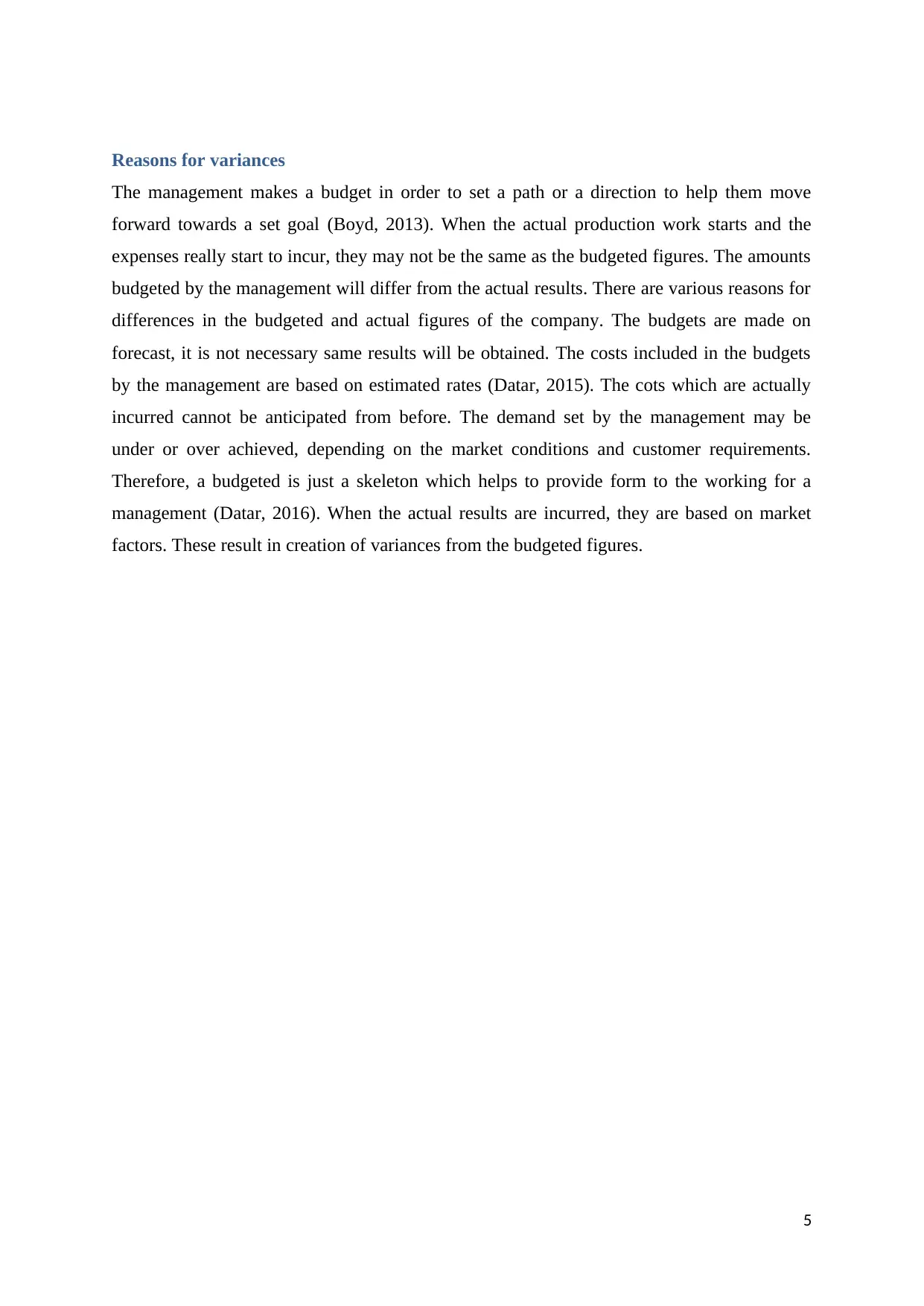
Reasons for variances
The management makes a budget in order to set a path or a direction to help them move
forward towards a set goal (Boyd, 2013). When the actual production work starts and the
expenses really start to incur, they may not be the same as the budgeted figures. The amounts
budgeted by the management will differ from the actual results. There are various reasons for
differences in the budgeted and actual figures of the company. The budgets are made on
forecast, it is not necessary same results will be obtained. The costs included in the budgets
by the management are based on estimated rates (Datar, 2015). The cots which are actually
incurred cannot be anticipated from before. The demand set by the management may be
under or over achieved, depending on the market conditions and customer requirements.
Therefore, a budgeted is just a skeleton which helps to provide form to the working for a
management (Datar, 2016). When the actual results are incurred, they are based on market
factors. These result in creation of variances from the budgeted figures.
5
The management makes a budget in order to set a path or a direction to help them move
forward towards a set goal (Boyd, 2013). When the actual production work starts and the
expenses really start to incur, they may not be the same as the budgeted figures. The amounts
budgeted by the management will differ from the actual results. There are various reasons for
differences in the budgeted and actual figures of the company. The budgets are made on
forecast, it is not necessary same results will be obtained. The costs included in the budgets
by the management are based on estimated rates (Datar, 2015). The cots which are actually
incurred cannot be anticipated from before. The demand set by the management may be
under or over achieved, depending on the market conditions and customer requirements.
Therefore, a budgeted is just a skeleton which helps to provide form to the working for a
management (Datar, 2016). When the actual results are incurred, they are based on market
factors. These result in creation of variances from the budgeted figures.
5
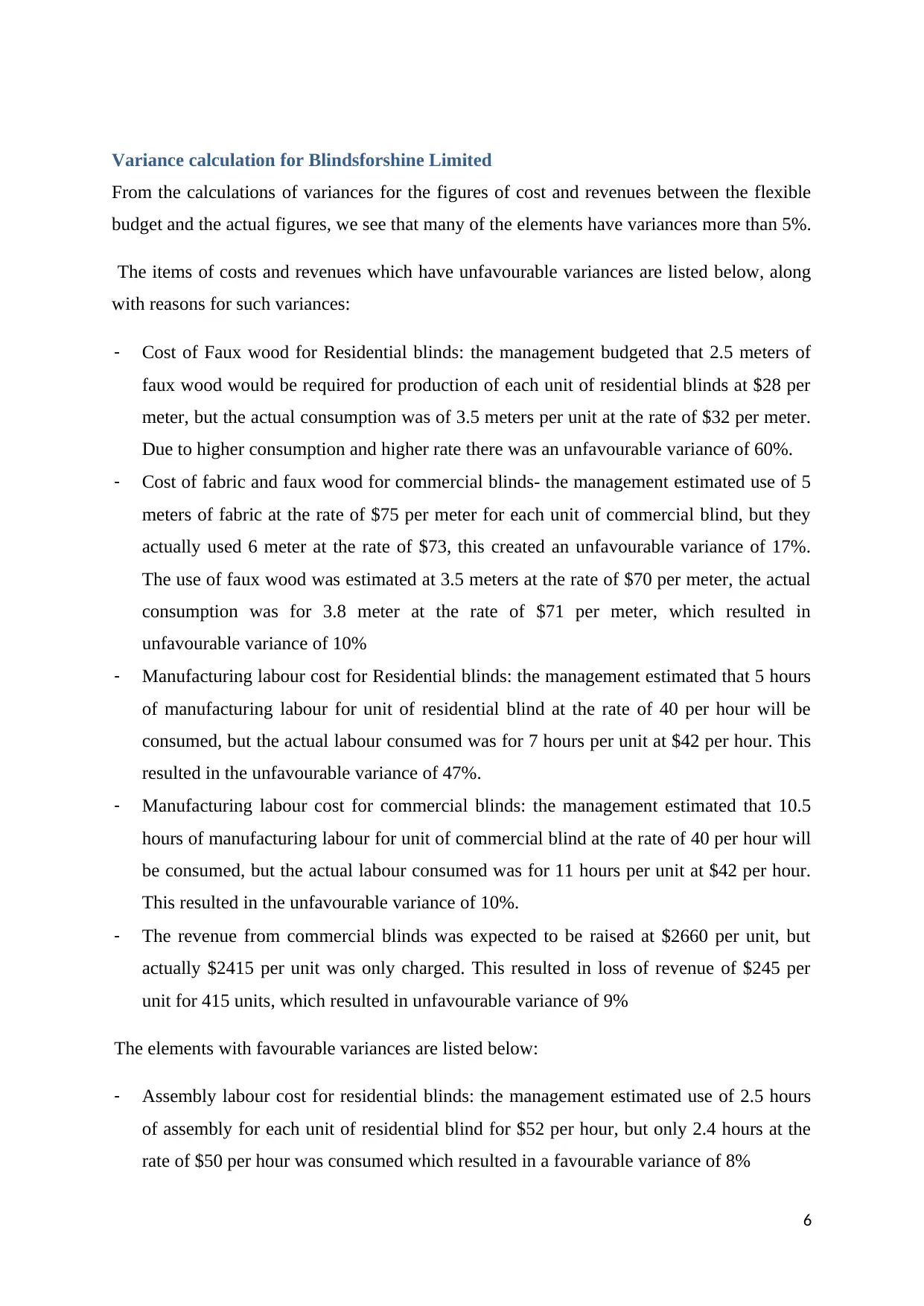
Variance calculation for Blindsforshine Limited
From the calculations of variances for the figures of cost and revenues between the flexible
budget and the actual figures, we see that many of the elements have variances more than 5%.
The items of costs and revenues which have unfavourable variances are listed below, along
with reasons for such variances:
- Cost of Faux wood for Residential blinds: the management budgeted that 2.5 meters of
faux wood would be required for production of each unit of residential blinds at $28 per
meter, but the actual consumption was of 3.5 meters per unit at the rate of $32 per meter.
Due to higher consumption and higher rate there was an unfavourable variance of 60%.
- Cost of fabric and faux wood for commercial blinds- the management estimated use of 5
meters of fabric at the rate of $75 per meter for each unit of commercial blind, but they
actually used 6 meter at the rate of $73, this created an unfavourable variance of 17%.
The use of faux wood was estimated at 3.5 meters at the rate of $70 per meter, the actual
consumption was for 3.8 meter at the rate of $71 per meter, which resulted in
unfavourable variance of 10%
- Manufacturing labour cost for Residential blinds: the management estimated that 5 hours
of manufacturing labour for unit of residential blind at the rate of 40 per hour will be
consumed, but the actual labour consumed was for 7 hours per unit at $42 per hour. This
resulted in the unfavourable variance of 47%.
- Manufacturing labour cost for commercial blinds: the management estimated that 10.5
hours of manufacturing labour for unit of commercial blind at the rate of 40 per hour will
be consumed, but the actual labour consumed was for 11 hours per unit at $42 per hour.
This resulted in the unfavourable variance of 10%.
- The revenue from commercial blinds was expected to be raised at $2660 per unit, but
actually $2415 per unit was only charged. This resulted in loss of revenue of $245 per
unit for 415 units, which resulted in unfavourable variance of 9%
The elements with favourable variances are listed below:
- Assembly labour cost for residential blinds: the management estimated use of 2.5 hours
of assembly for each unit of residential blind for $52 per hour, but only 2.4 hours at the
rate of $50 per hour was consumed which resulted in a favourable variance of 8%
6
From the calculations of variances for the figures of cost and revenues between the flexible
budget and the actual figures, we see that many of the elements have variances more than 5%.
The items of costs and revenues which have unfavourable variances are listed below, along
with reasons for such variances:
- Cost of Faux wood for Residential blinds: the management budgeted that 2.5 meters of
faux wood would be required for production of each unit of residential blinds at $28 per
meter, but the actual consumption was of 3.5 meters per unit at the rate of $32 per meter.
Due to higher consumption and higher rate there was an unfavourable variance of 60%.
- Cost of fabric and faux wood for commercial blinds- the management estimated use of 5
meters of fabric at the rate of $75 per meter for each unit of commercial blind, but they
actually used 6 meter at the rate of $73, this created an unfavourable variance of 17%.
The use of faux wood was estimated at 3.5 meters at the rate of $70 per meter, the actual
consumption was for 3.8 meter at the rate of $71 per meter, which resulted in
unfavourable variance of 10%
- Manufacturing labour cost for Residential blinds: the management estimated that 5 hours
of manufacturing labour for unit of residential blind at the rate of 40 per hour will be
consumed, but the actual labour consumed was for 7 hours per unit at $42 per hour. This
resulted in the unfavourable variance of 47%.
- Manufacturing labour cost for commercial blinds: the management estimated that 10.5
hours of manufacturing labour for unit of commercial blind at the rate of 40 per hour will
be consumed, but the actual labour consumed was for 11 hours per unit at $42 per hour.
This resulted in the unfavourable variance of 10%.
- The revenue from commercial blinds was expected to be raised at $2660 per unit, but
actually $2415 per unit was only charged. This resulted in loss of revenue of $245 per
unit for 415 units, which resulted in unfavourable variance of 9%
The elements with favourable variances are listed below:
- Assembly labour cost for residential blinds: the management estimated use of 2.5 hours
of assembly for each unit of residential blind for $52 per hour, but only 2.4 hours at the
rate of $50 per hour was consumed which resulted in a favourable variance of 8%
6
⊘ This is a preview!⊘
Do you want full access?
Subscribe today to unlock all pages.

Trusted by 1+ million students worldwide
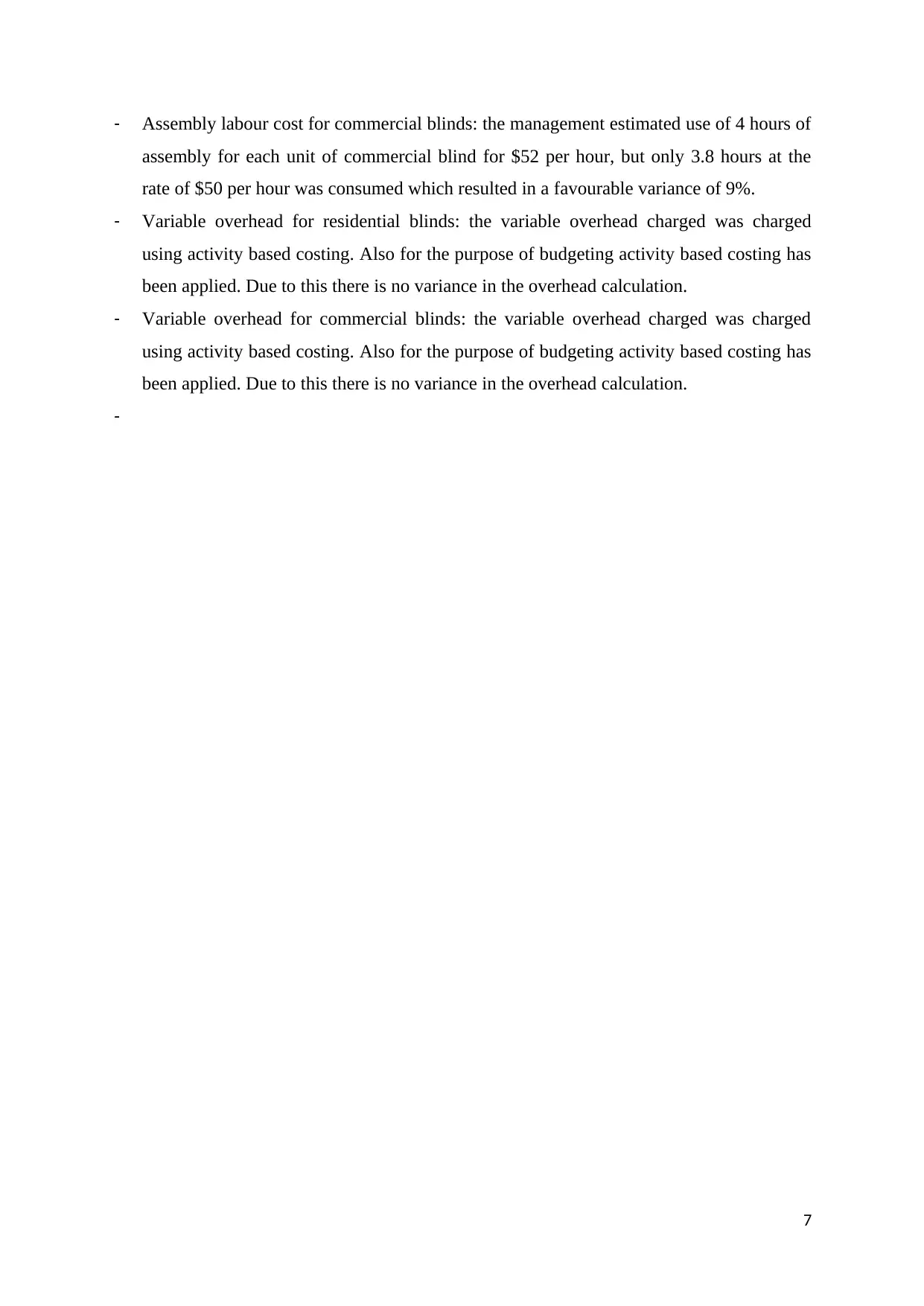
- Assembly labour cost for commercial blinds: the management estimated use of 4 hours of
assembly for each unit of commercial blind for $52 per hour, but only 3.8 hours at the
rate of $50 per hour was consumed which resulted in a favourable variance of 9%.
- Variable overhead for residential blinds: the variable overhead charged was charged
using activity based costing. Also for the purpose of budgeting activity based costing has
been applied. Due to this there is no variance in the overhead calculation.
- Variable overhead for commercial blinds: the variable overhead charged was charged
using activity based costing. Also for the purpose of budgeting activity based costing has
been applied. Due to this there is no variance in the overhead calculation.
-
7
assembly for each unit of commercial blind for $52 per hour, but only 3.8 hours at the
rate of $50 per hour was consumed which resulted in a favourable variance of 9%.
- Variable overhead for residential blinds: the variable overhead charged was charged
using activity based costing. Also for the purpose of budgeting activity based costing has
been applied. Due to this there is no variance in the overhead calculation.
- Variable overhead for commercial blinds: the variable overhead charged was charged
using activity based costing. Also for the purpose of budgeting activity based costing has
been applied. Due to this there is no variance in the overhead calculation.
-
7
Paraphrase This Document
Need a fresh take? Get an instant paraphrase of this document with our AI Paraphraser

Recommendations on control of variances:
The cases of favourable variances are good for the company. They represent savings done by
them with respected to set level of costs. The unfavourable variances on the hand represent
the extra cost incurred by the management than the set limits. There are various steps that can
be taken by the management in order to ensure limited cost (Horngren, 2012). The
management can set incentive options for the departments who execute the projects with the
allocated resources. This will drive the employees to work more efficiently with the given
resources and will prevent extra material cost. The management should also opt of methods
which will helps to reduce wastages. A proper check on labours hours should be made in
order to ensure that the idle hours are not more than budgeted (Menifield, 2014). Limiting the
idle hours will promote productive hours and result in savings of labour cost. The
management should also use activity based costing in order to recover actual overheads, use
of traditional costing may lead to over pricing of the product which will affect the demand
and revenue (Noreen, 2015). Steps to ensure lower costs and higher revenues should be taken
by the management in order to avoid unfavourable variances.
8
The cases of favourable variances are good for the company. They represent savings done by
them with respected to set level of costs. The unfavourable variances on the hand represent
the extra cost incurred by the management than the set limits. There are various steps that can
be taken by the management in order to ensure limited cost (Horngren, 2012). The
management can set incentive options for the departments who execute the projects with the
allocated resources. This will drive the employees to work more efficiently with the given
resources and will prevent extra material cost. The management should also opt of methods
which will helps to reduce wastages. A proper check on labours hours should be made in
order to ensure that the idle hours are not more than budgeted (Menifield, 2014). Limiting the
idle hours will promote productive hours and result in savings of labour cost. The
management should also use activity based costing in order to recover actual overheads, use
of traditional costing may lead to over pricing of the product which will affect the demand
and revenue (Noreen, 2015). Steps to ensure lower costs and higher revenues should be taken
by the management in order to avoid unfavourable variances.
8
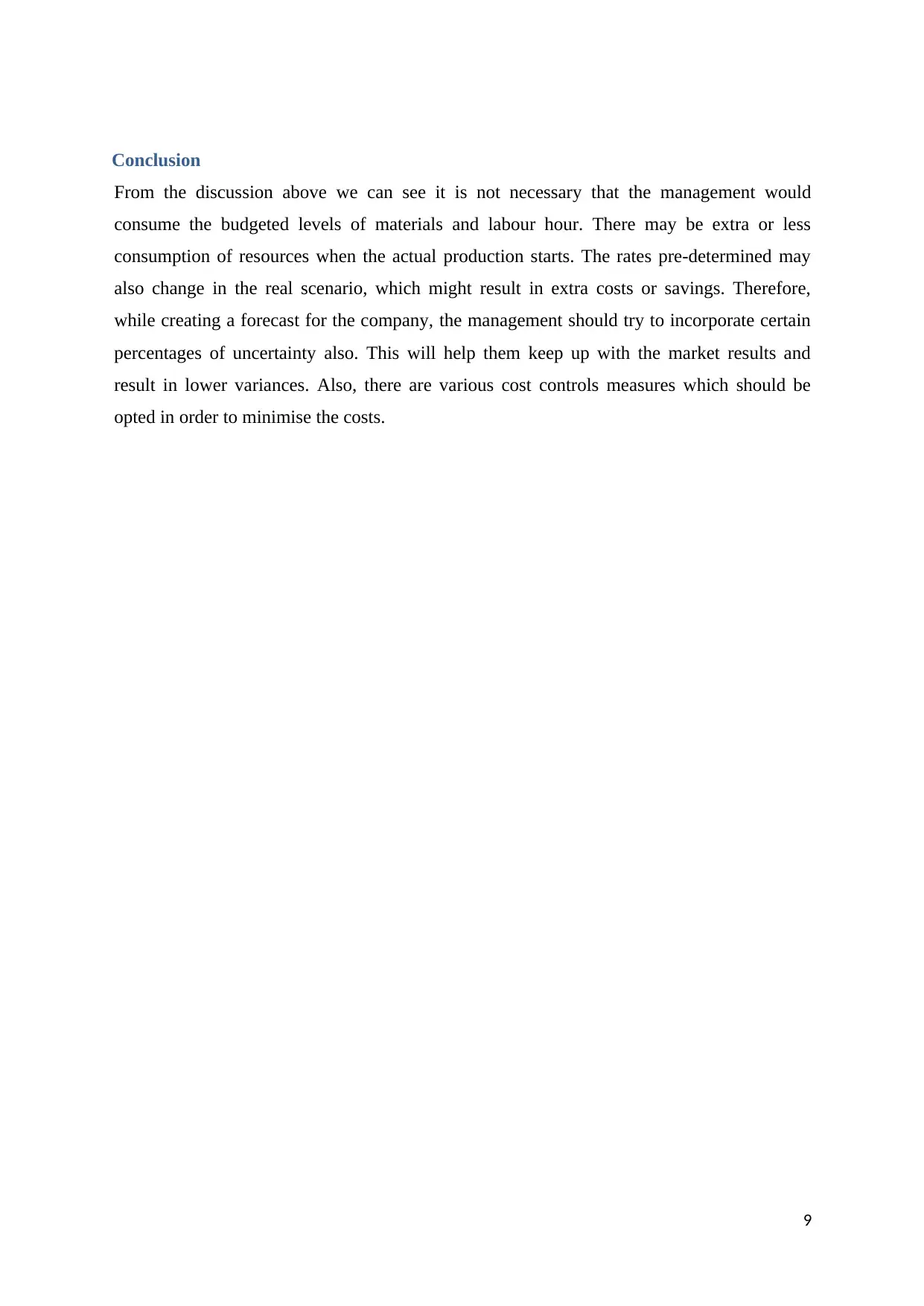
Conclusion
From the discussion above we can see it is not necessary that the management would
consume the budgeted levels of materials and labour hour. There may be extra or less
consumption of resources when the actual production starts. The rates pre-determined may
also change in the real scenario, which might result in extra costs or savings. Therefore,
while creating a forecast for the company, the management should try to incorporate certain
percentages of uncertainty also. This will help them keep up with the market results and
result in lower variances. Also, there are various cost controls measures which should be
opted in order to minimise the costs.
9
From the discussion above we can see it is not necessary that the management would
consume the budgeted levels of materials and labour hour. There may be extra or less
consumption of resources when the actual production starts. The rates pre-determined may
also change in the real scenario, which might result in extra costs or savings. Therefore,
while creating a forecast for the company, the management should try to incorporate certain
percentages of uncertainty also. This will help them keep up with the market results and
result in lower variances. Also, there are various cost controls measures which should be
opted in order to minimise the costs.
9
⊘ This is a preview!⊘
Do you want full access?
Subscribe today to unlock all pages.

Trusted by 1+ million students worldwide
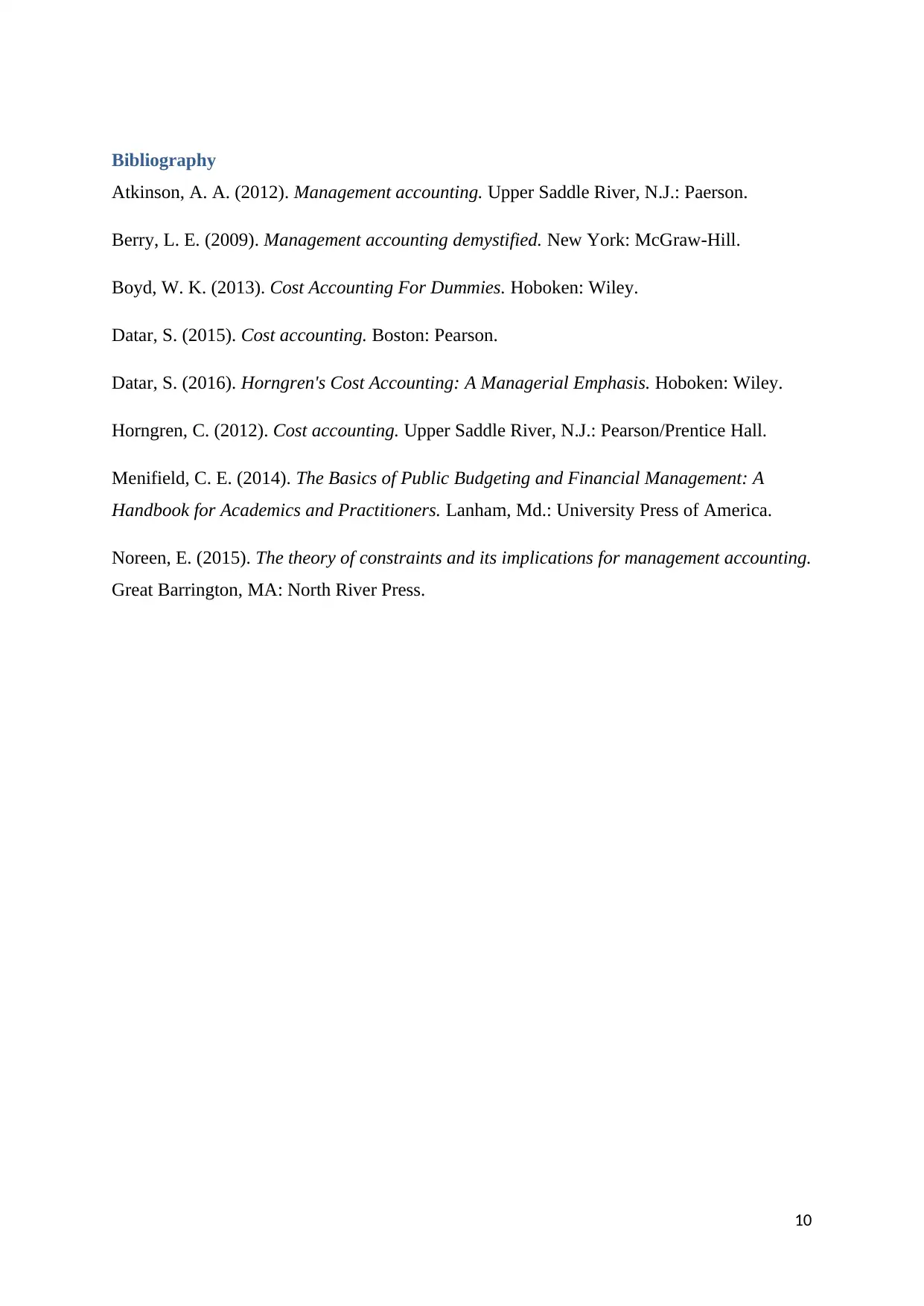
Bibliography
Atkinson, A. A. (2012). Management accounting. Upper Saddle River, N.J.: Paerson.
Berry, L. E. (2009). Management accounting demystified. New York: McGraw-Hill.
Boyd, W. K. (2013). Cost Accounting For Dummies. Hoboken: Wiley.
Datar, S. (2015). Cost accounting. Boston: Pearson.
Datar, S. (2016). Horngren's Cost Accounting: A Managerial Emphasis. Hoboken: Wiley.
Horngren, C. (2012). Cost accounting. Upper Saddle River, N.J.: Pearson/Prentice Hall.
Menifield, C. E. (2014). The Basics of Public Budgeting and Financial Management: A
Handbook for Academics and Practitioners. Lanham, Md.: University Press of America.
Noreen, E. (2015). The theory of constraints and its implications for management accounting.
Great Barrington, MA: North River Press.
10
Atkinson, A. A. (2012). Management accounting. Upper Saddle River, N.J.: Paerson.
Berry, L. E. (2009). Management accounting demystified. New York: McGraw-Hill.
Boyd, W. K. (2013). Cost Accounting For Dummies. Hoboken: Wiley.
Datar, S. (2015). Cost accounting. Boston: Pearson.
Datar, S. (2016). Horngren's Cost Accounting: A Managerial Emphasis. Hoboken: Wiley.
Horngren, C. (2012). Cost accounting. Upper Saddle River, N.J.: Pearson/Prentice Hall.
Menifield, C. E. (2014). The Basics of Public Budgeting and Financial Management: A
Handbook for Academics and Practitioners. Lanham, Md.: University Press of America.
Noreen, E. (2015). The theory of constraints and its implications for management accounting.
Great Barrington, MA: North River Press.
10
1 out of 10
Related Documents
Your All-in-One AI-Powered Toolkit for Academic Success.
+13062052269
info@desklib.com
Available 24*7 on WhatsApp / Email
![[object Object]](/_next/static/media/star-bottom.7253800d.svg)
Unlock your academic potential
Copyright © 2020–2025 A2Z Services. All Rights Reserved. Developed and managed by ZUCOL.





